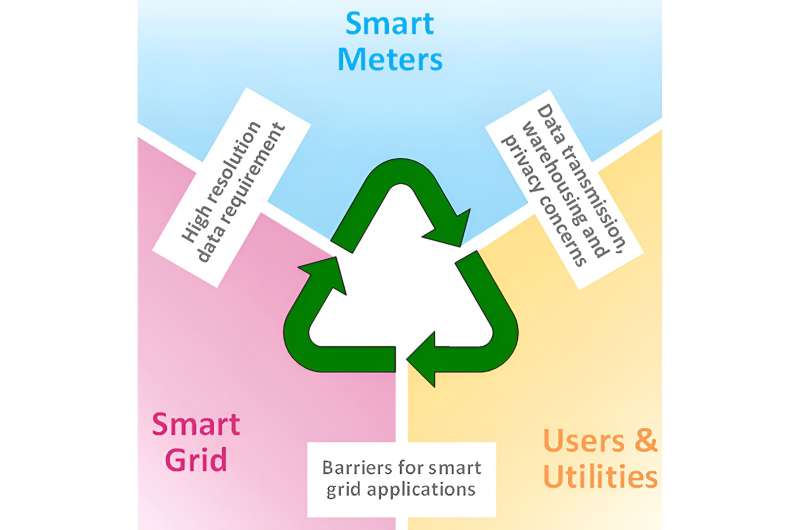This article has been reviewed according to Science X's editorial process and policies. Editors have highlighted the following attributes while ensuring the content's credibility:
fact-checked
peer-reviewed publication
trusted source
proofread
Path to lower emissions demands a smarter grid, say researchers

Researchers at the University of Adelaide believe the global investment being made in smart metering infrastructure could fall short of fulfilling promised benefits to customers if key systems issues are not addressed.
Throwing open the challenge to other energy systems researchers, Dr. Ali Pourmousavi Kani from the University's School of Electrical and Mechanical Engineering, says smart meters and smart metering systems require a new level of sophistication if they are to play a useful role in supporting more efficient energy use and smart functioning grids.
Research from Dr. Pourmousavi Kani's team, led by Ph.D. candidate Rui Yuan, examined the data that are gathered from energy systems in Australia, Europe and North America.
The team's findings, published in the journal Cell Reports Physical Science, reveal inadequate sampling resolution and frequency of communication of electricity consumption data, and a failure to address a range of data issues such as data warehousing and privacy concerns.
"Issues with data gathering from energy systems present significant handicaps to the emergence of truly smart grids," Yuan says.
"In Australia and around the world there is a push to install new and smart digital meters that have the capacity for two-way communication to the grid.
"For instance, the Australian Energy Market Commission (AEMC) has recommended 100% uptake of smart meters by 2030, and the EU expects 225 million smart electricity meters to be installed by 2024.
"However, most smart metering infrastructure doesn't yet have the capacity or is not operated to communicate consumption data in more than 30 minutes to one hour sampling resolution in real time and feed that back to consumers and service providers."
The quality of energy consumption data depends on the frequency that it is collected: higher frequency of collection provides a better picture of consumption patterns.
"Big promises came along with the push to digitize the energy grid, including many benefits to consumers from features that would allow them to monitor their energy use and make choices to opt into better services that could be provided by third parties," says Yuan.
"In the U.S. less than 3% of smart meters can deliver on these promises, and globally the situation is similar."
For example, Yuan says, the European Commission reported that 7 out of the 16 countries undergoing widespread deployment of smart meters lacked the ability to even relay consumption data back to consumers, and in parts of Canada, wireless smart meters are only read every 30 or 60 days in line with the normal manually-read billing cycle.
The research team touched on several barriers to developing high functioning smart metering infrastructure.
"In Europe we found that smart meters did not have the bandwidth required to transmit the large amounts of data for high resolution readings and in parts of Asia there were issues with slow communication links," Kani says.
"Another disincentive to capturing and keeping high resolution energy-use data is the cost of data warehousing.
"Data warehousing is estimated to cost between US$19,000 and US$25,000 annually per terabyte, so any push to increase energy-use data resolution from say an hour to every two seconds has a multimillion-dollar cost attached.
"There are pitfalls to collecting high-resolution real-time data from consumers because it also leaves them vulnerable and opens up tricky privacy issues.
"Tracking the data provides information indicating when people are home or out and how often—so it reveals occupancy patterns.
"It can also suggest certain kinds of criminal activity—for example the cultivation of illegal crops and there are examples of law enforcement agencies using such data in their investigations.
"If the information is hacked it opens up a range of safety, ethical, and privacy issues for consumers."
Kani says the research team has worked to develop a new approach to smart metering that may offer solutions to the three key problems inherent in current systems—data transmission, data warehousing, and data privacy.
"Our solution, while still in its early stages of development, aims to enable high-resolution data capturing," he says.
"This technology not only prioritizes consumer privacy but also ensures cost-effective data storage and low communication bandwidth requirement.
"The ultimate goal is to empower consumers to fully reap the benefits of smart metering infrastructure."
More information: Rui Yuan et al, Unleashing the benefits of smart grids by overcoming the challenges associated with low-resolution data, Cell Reports Physical Science (2024). DOI: 10.1016/j.xcrp.2024.101830

















